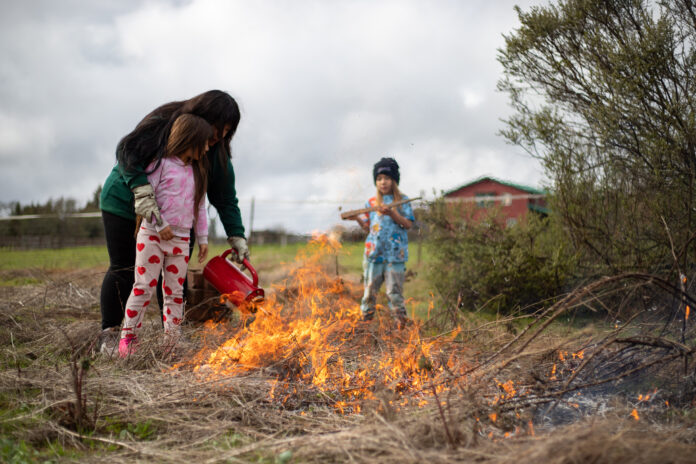In the last weekend of February, as another rain storm soaked Sonoma County, over 40 people from around California gathered in Santa Rosa to reconnect with fire.
On that Sunday morning, participants gathered at the California Indian Museum and Culture Center before heading to the Heron Shadow, a property used by The Cultural Conservancy as a refuge for Indigenous food and culture.
There, attendees took turns lighting piles of sticks and other plant material. The gathering was the last in a series of five events held throughout northern California, titled “Rekindling Culture and Fire.”
Attendees were drawn together by a desire “to put fire on the land in a healthy way,” Cody Walker, a board member of the California Indian Basketweavers’ Association (CIBA) and member of the Chukchansi tribe, said. “When fire comes down like the Tubbs fire, that’s bad fire. It’s destructive.”
The Rekindling series, organized by CIBA in partnership with other nonprofits, comes at a time of renewed interest and access to cultural and prescribed burns. Many Indigenous attendees of the Santa Rosa event knew the benefits of “good fire” before the Tubbs Fire struck. However, that disaster helped to bring broader attention to the problems with America’s forest management strategies, which, for decades, have greatly restricted the use of intentional fires, allowing fuel to build up, strengthening wildfires.
For much of the 20th century, the U.S. Forest Service implemented “fire exclusion” policies aimed at protecting lumber and structures, according to a February 2021 study in Fire Ecology. In California, this included a ban on cultural burning, a tradition of many tribes long predating the arrival of European colonizers.
“From the 1920s to the 2000s, fire exclusion policies and regulations against cultural burning increased the scarcity of suitable basketry stems for basketweavers,” the Fire Ecology study states.
For thousands of years before the restrictive policies, Indigenous people used cultural burns to enhance the production of basket weaving materials, including producing straight and strong hazelnut stems. Baskets are used for child-rearing, storage and ceremonies. Now, groups like CIBA are trying to reconnect with the entire process, from tending to the land with cultural burns to creating baskets with the resulting materials.
“It really is a way of life, not just a once a year thing. You tend to the land, grow really nice sticks, harvest the sticks and put the sticks and plants together to create a beautiful basket,” Walker said.


Legalizing Fire
As Indigenous groups continue to reintroduce cultural fires, public agencies and private property owners are warming up to the use of prescribed burns.
A 2020 Stanford University study recommended that California increase use of prescribed burns on private property as a tool to decrease the risk of massive wildfires. The researchers found that, after decades of fuel build-up, the state needed to reduce fuel loads on about 20 million acres, approximately 20% of the state.
However, a variety of factors, including property owners’ insurance concerns, stigma about fire and restrictive regulations, have discouraged the use of planned burns.
In recent years, state lawmakers have eased some rules and set up a pot of money to offset possible costs to private landowners. Last March, Gov. Gavin Newsom’s Wildfire and Forest Resilience Task Force announced a plan to burn 400,000 acres per year by 2025 as part of the state’s wildfire mitigation strategy.
“We know that returning good fire to the ground is one of our best tools in the fight against catastrophic wildfire and climate change,” Wade Crowfoot, the state’s Natural Resources secretary, said in a statement announcing the task force’s plan. The federal government has also set aside funding to increase the use of prescribed burns in high-risk areas.
Still, such planned fires aren’t totally without risk. Last summer, for instance, New Mexico suffered the largest wildfire in recorded history, after prescribed burns started by the U.S. Forest Service escaped.
However, Michael Wara, a Stanford researcher, has said that only two of 400 prescribed burns on private property over three recent years escaped, causing minimal damage. Most prescribed and cultural burns on private property are much smaller than the ones the Forest Service uses.
And, despite the small risk planned burns pose, the previous fire management model clearly didn’t work either.
Standing under a tent at Heron Shadow, Ron Goode, tribal chairman of the North Fork Mono Tribe and a long-time cultural fire practitioner, reflected on the difference between Indigenous and western approaches to wilderness management. Despite recent wildfires burning a huge amount of northern California, Goode said that government agencies still aren’t doing enough to work on areas that didn’t burn, instead focusing on clearcutting areas that did.
“Right now, the United States government says, ‘Wilderness, that’s a good thing, because if we leave it alone, we don’t have to do anything with it. And it won’t cost us anything.’ Those are the two items they’re after: don’t have to do any work on it and don’t have to pay anything for it,” Goode said.
Indigenous groups favor a closer, ongoing relationship with the land, which Goode likened to tending a garden.
“I tell them, ‘Is that how you build a garden? You don’t clean up the ground first, you don’t clean up last year’s crop and then you plant all your plants right next to each other? That’s not how you do a garden, and that’s what the forest is: a garden that needs to be tended,’” he reflected.
“From the Native American standpoint, that’s what we’re saying. We’re here to restore. We’re here to rejuvenate. We’re here to regenerate,” Goode said. “Yes, we still take. We still use the resources, but our impact is nothing like the [government] agencies’ impacts.”
The Santa Rosa Junior College’s Multicultural Museum is currently showing 130 masterfully woven baskets from the Elsie Allen Pomo Basket Collection. ‘Breaking Traditions, Saving Traditions: Elsie Allen & the Legacy of Pomo Basketry’ is open Monday thru Saturday until Dec. 22.












